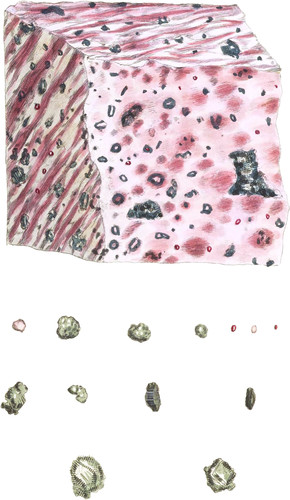 Enlarge
Enlarge
British Mineralogy
Variegated Limestone; or Tirie Marble
- Class 2. Earths.
- Order 1. Homogeneous.
- Gen. 3. Lime.
- Spec. 4. Carbonate of Lime.
- Var. 3. Amorphous.
- Syn. Common compact limestone. Syst. Min. Jameson, 477.
This beautiful variegated limestone comes from the hill of Belephetrich in Tirie, one of the western islands of Scotland, it is said to be a primitive limestone, but is not mentioned in Mr. Kirwan’s Geological Essays. It has all the common characters of a limestone, with a fine splintery fracture*. It is admired for the white and red, blending and softening into spots, blotches, and undulating straiæ, more or less interrupted by bright little red stones sticking within it like garnets†, which are somewhat transparent, smooth, irregular, and seem to be quartz (see the lower red-coloured figures): also white transparent calcareous spar with the common rhomboidal lameller fracture is occasionally mixed with the stone; but more especially a light or dark olive green substance, either of an earthy or shining appearance. The earthy sort at first sight resembles chlorite, but is more or less rhomboidal in its fracture. It seems to be mixed with quartz, and is irregular as to hardness. This green substance is mostly very irregular as to a shape. We could only discover a small inclination to hexangular columns with irregular ends: these are sometimes smooth and shining, and have whitish transverse straiæ, which give them the appearance of an onyx: these straiæ are softer than the other parts (see the middle figures): some of these have a resemblance to jade, as Raspe observed, but perhaps only from their outward smooth aspect. The lighter ones, we presume, differ only in colour, and are probably the same substance; indeed, Jameson calls them all hornblendes. We have had the pleasure, though the kindness of Mr. Hatchett, of seeing the corundum from Tirie, spoken of by Mr. Jameson, and find it the same substance with these crystals, only much lighter in colour: but as Mr. Greville observes, they are not fusible, as Kirwan and Jameson say hornblende is, therefore they cannot be hornblende; nor are they now supposed to be corundum, although the external appearance of the lighter varieties much resembles that substance. We, at present, only mention these crystals because they occur in the Tirie marble, but must show larger specimens, and explain them further hereafter.
Mr. Jameson in his Mineralogy of Scotland, v. 2. 30. describes the red-coloure dmarble of Belephetrich as follows:
- Colour, pale blood red, light flesh red, and reddish white.
- Lustre, none, except from a number of dispersed shining foliæ.
- Fracture, fine splintery.
- Transparency: transmits light freely at the edges.
- Hardness: yields pretty easily to the knife.
- * Primitive limestone is not always white, nor is the grain of it always very perceptibly scaly or lamellar; but approaches, by reason of its minuteness, so nearly to the compact as to pass for such: nay, it is said sometimes to discover a splintery fracture, but very rarely; sometimes its texture approaches to the fibrous. Kirwan’s Geo. Ess. 215.
- † Jameson says it contains little garnets: we do not find any in the quantity of some tons which we have had the opportunity of examining.

